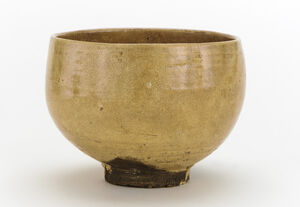
Hagi ware Japanese tea bowl, 18th-19th century, Freer Gallery of Art
Hagi ware (萩焼 Hagi-yaki) is a type of Japanese pottery most identifiable for its humble forms and use of translucent white glaze.
It originated in the early 17th century with the introduction of potters brought back from Japanese invasions of Korea.[1][2][3] The local daimyo of the time were very interested in tea ceremony and funded production of this ware.
Potters mix different types of local clay. The most standard result is a pink-orange color, called Korean clay. Wares are formed on the wheel and decorated with translucent glaze made of feldspar and ash.
The signature chip located on the bottom is a local tradition from the Edo period when potters would deliberately mark their wares in order to sell them to merchants instead of presenting them as gifts to the Mori clan.
References[]
- ↑ Purple Tigress (August 11, 2005). Review: Brighter than Gold - A Japanese Ceramic Tradition Formed by Foreign Aesthetics. BC Culture. Retrieved on 2008-01-10.
- ↑ Muromachi period, 1392-1573. Metropolitan Museum of Art (October 2002). Retrieved on 2008-01-10. “1596 Toyotomi Hideyoshi invades Korea for the second time. In addition to brutal killing and widespread destruction, large numbers of Korean craftsmen are abducted and transported to Japan. Skillful Korean potters play a crucial role in establishing such new pottery types as Satsuma, Arita, and Hagi ware in Japan. The invasion ends with the sudden death of Hideyoshi.”
- ↑ John Stewart Bowman (2002). Columbia Chronologies of Asian History and Culture. Columbia University Press. pp. 170p. ISBN 0231110049.
- Wilson, Richard L. Inside Japanese Ceramics. Weatherhill, New York and Tokyo, Second Edition 2005. ISBN 0-8348-0442-5
External links[]
- "What is Hagi Guidebook" on e-yakimono.net [1]
- "A Visit To Hagi - The Work of Three Hagi Artists" on e-yakimono.net [2]
- Handbook for the Appreciation of Japanese Traditional Crafts [3]

